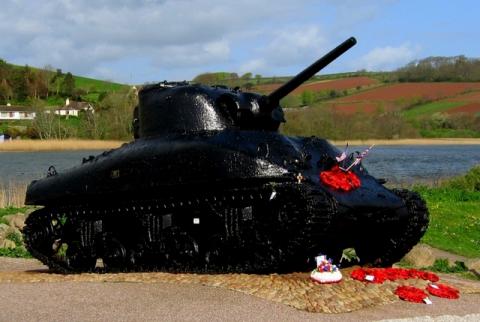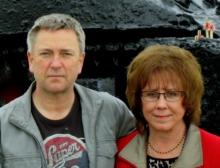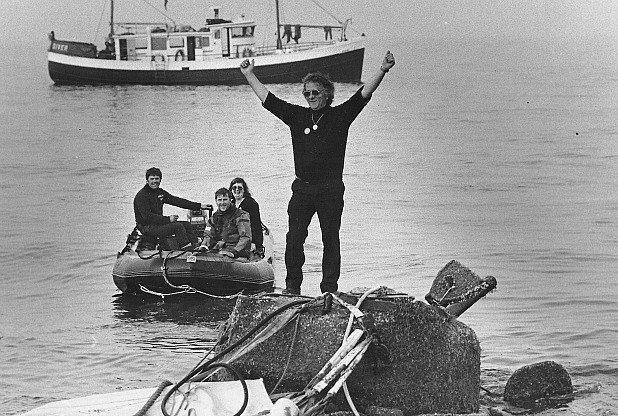Our website was created to help the family members of those who died and participated in Exercise Tiger. Dean Small, son of the late Ken Small, continues with his father's legacy. We are endorsed by the survivors and the families.
70th anniversary tribute to Ken Small - April 26, 2014
Submitted by Chris on Sat, 26/04/2014 - 19:50


|
The Sherman tank recovered by Ken Small from the sea off Slapton Sands in South Devon |
| 70th Anniversary tribute to the man who exposed Exercise Tiger tragedy |
WESTERN MORNING NEWS APRIL 26, 2014
The late Ken Small who recovered a Sherman tank from the sea at Slapton Sands, is to be honored at a 70th Anniversary service for Exercise Tiger. Simon Parker spoke to his son about the story behind a remarkable World War II memorial. See Page 2 below.
D-Day practice more deadly than real thing
Exercise Tiger proved to be the most deadly training incident in the whole of the Second World War. The similarity between the Start Bay area and the Normandy coast prompted its use for several full-scale battle practices. Slapton Sands was thought to be a perfect place to simulate landings for Utah Beach in France as part of Operation Overlord on June 6, 1944.
In the early morning hours of April 28, 1944, eight landing ship tanks (LSTs) full of American servicemen and equipment converged in Lyme Bay and made their way towards Slapton Sands for a D-Day rehearsal. Four German E-Boats alerted by heavy radio traffic, intercepted the three-mile convoy of vessels and the heavily laden, slow-moving LSTs proved easy targets for the torpedo boats. A series of tragedies, including the absence of British Navy destroyer assigned as an escort and an error in radio frequencies, led to three of the LSTs being hit by torpedoes. More loss of life was caused by life jackets being incorrectly worn and the extreme cold of the sea. A total of 749 soldiers and sailors died. The loss of life was greater than that later suffered by the assault troops during the initial attack on Utah Beach.
Allied commanders, fearing the news might make its way into German hands and reveal the intentions for the D-Day landings immediately ordered a communication blackout. Approximately 12 weeks before the military exercises, many of the villages surrounding Slapton Sands had been evacuated. The soldiers who survived were ordered not to speak about the incident, and many did not talk about it until 50 years later. It remained a secret until Ken Small, then a Torcross hotelier, was told about a Sherman Duplex Drive tank that was resting on the sea bed three-quarters of a mile out from the shore.
After negotiations over several years, he bought it from the US Government for $50, finally recovering it from the sea in May 1984. Thanks to his efforts, the Sherman Tank Memorial was officially recognised by the US Congress and acknowledged by the addition of a bronze plaque.
As Ken Small walked along Slapton Sands one day in the early 1970’s he could never have imaged that the bracing stroll would lead to the exposure of a perceived Second World War cover-up by the US military. He would also not have known that the discovery of a few buttons and coins would result in the events surrounding Exercise Tiger becoming an all-consuming interest for the rest of his life.
Thanks to Ken’s tenacity, we now know that on 28 April 1944, German E-Boats attacked a US convoy during a rehearsal exercise for the D-Day landings off South Devon. Seven hundred and forty-nine American servicemen died. The ill-fated exercise was considered by US top brass to be such a propaganda disaster that they ordered a complete information black-out, with the threat of court martial for any survivor who revealed the truth about what happened.
And it might have remained a secret for many more years, had Ken Small not taken up beachcombing. Ken’s son, Dean Small explained: “My parents moved to Devon from Grimsby in the late 1960’s and ran a guesthouse in Torcross. During a short illness, and as part of his recuperation, my dad used to walk the length of Slapton Sands. It was during one of this regular strolls that he began to notice unusual objects on the tide-line. There were tunic buttons, bullet cases, shrapnel and coins. He asked around locally and that’s when he was told that the villages had been evacuated for wartime exercises.
“Then, when a friend said something on the seabed kept snagging fishermen’s nets, he became fascinated. So when this guy went diving and found it was a Sherman Tank, there was really no going back.”
As Ken learned more about Exercise Tiger and the terrible death toll, he decided to recover the tank and dedicate it as a memorial to those who lost their lives. After some years of negotiating with the American government, contacting US Veterans around the world and even speaking to members of the E-Boat crews who torpedoed the convoy, Ken finally achieved his objective in May 1984. As soon as the thank was out of the water the story went international and he received countless letters from veterans and their families and was officially thanked by US President Ronald Reagan.
 |
|
Dean Small & Laurie Bolton |
“I still find it amazing that he managed it,” said Dean, who took on the job of tank caretaker after his father’s death. “I am a decorator so I always paint it and keep it tidy. I do it for my dad and for the veterans and their families.
“I’m incredibly proud of what my dad did and it has become even more meaningful since he died. When I look at what he achieved and hear how much it means to people it chokes me up. He didn’t do it for himself, but for the veterans and their families because he believed it was the right thing to do. The tank will always be a symbol and a war memorial, where people can go and remember and learn.” Ken, who died in 2004, wrote a book about the events surrounding Exercise Tiger in which, among other things, he asserts that the US military did not cover up the event, but that it was “conveniently forgotten” until he resurrected it in the 1970’s.
A plaque to Ken Small will be unveiled by Laurie Bolton, who has traveled from her home in California for tomorrow’s event. Laurie, whose uncle, Sergeant Louis Bolton died in Exercise Tiger, got to know Ken Small after discovering her family link to the tragedy. She has been visiting Slapton Sands for 20 years, bringing groups of veterans and family members for the 60th and 65th anniversaries, and last year in 2013. She said it is unlikely any veteran survivors will be able to attend this year. “I am honored to be asked to unveil the plaque in memory of Ken and to pay tribute to his dedication over 30 years,” she said. “The tank memorial gives us a tangible place to come and pay tribute to our loved ones who died, as well as a place of remembrance for their sacrifice. I am grateful to Dean for carrying on his father’s legacy and to all the local people who left their homes and farms for the cause of freedom.”
The 70th anniversary event is at the tank memorial in Torcross at 3:30 pm tomorrow. It will be led by Prebendary John Richards of the Royal Tank Regiment Association’s Plymouth Branch. Also present will be members of the LST & Landing Craft Association. All are welcome to attend.
PAGE 2
 |
|
Ken Small expresses his sense of triumph as the tank is raised in 1984 |
Dad’s efforts gave veterans ‘closure’
The importance of raising a tank from the seabed off Slapton and creating a memorial to 749 US servicemen was dramatically brought home to Ken Small one day in the late 1980s. He had been explaining the story to a group of visitors when a taxi drew up and an elderly man got out. Ken’s son Dean takes up the story: “I was there with my dad and this guy sort of fell out of the car and came straight across to us. He almost stumbled into my dad’s arms and was in floods of tears.”
It transpired that the American was a war veteran who had taken part in Exercise Tiger. Like his comrades on that fateful day in April 1944, he had never spoken a word of the tragedy in four decades. It was only when Ken’s campaign to raise the tank was reported on US television that he was able to share his experiences with family and friends. “He saw it on the news and within 48 hours had booked a flight to London,” said Dean. “When he arrived at Heathrow, he climbed into a taxi and told the cabbie to drive him to Slapton – even when the driver warned him it was a very long way.” When he arrived, he and my dad talked for quite a while. Until that moment this man hadn’t known who of his pals had made it through Exercise Tiger and who had perished and my dad was able to consult his lists and tell him. The taxi driver waited and when the old soldier was ready he took him back to Heathrow and he flew home. “Without my dad’s efforts, that man would never have known the truth, would never had closure. It made me very proud and helped me to realise just how important my dad’s work had been.”
